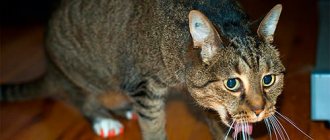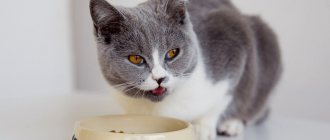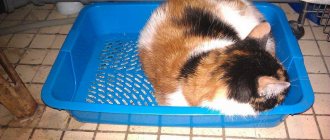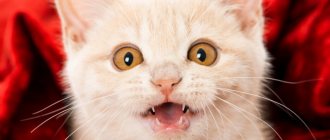Sometimes cats breathe with their mouths open, just like dogs. It’s unusual to see this “trick” performed by a domestic cat, and many owners begin to worry: is everything okay with their pet or is it time to run to the vet?
We hasten to reassure you: in most cases, breathing through a cat’s mouth is absolutely normal. But there are situations when this can be a wake-up call.
Let's talk about everything in order.
Why does a cat breathe like a dog?
In general, such breathing is unusual for cats. They usually breathe through their nose. They are less likely than dogs to have moments when they breathe intermittently with their mouths open. However, there are reasons why a cat can breathe with its mouth open, and they are not always a sign of pathology.
In most cases, these are physiological reasons characteristic of dogs. When should you not worry? It is necessary to discard anxiety if such breathing is caused by physiological reasons.
Why does a cat breathe like a dog?
- The female is preparing to become a mother. Before giving birth, the animal can indeed open its mouth wide and stick out its tongue.
- Increased room temperature. That is, during the heat, the animal can also inhale with its mouth wide open and intermittently. In this case, bring the animal home from the street, or, conversely, take it for a walk. Take care to cool the cat's area. Remember that animals, like people, can suffer from heatstroke. Therefore, an increase in temperature for a long period of time can harm the animal.
- Active games. If your animal frolicked, had fun, ran, rode on curtains, then such breathing is not surprising. The animal has expended a lot of energy, so a lot of oxygen is required to restore the body’s functioning. Therefore, the animal inhales by opening its mouth and sticking out its tongue.
- Stress. If the animal is frightened or uninvited guests come to your house, then such breathing is quite understandable. Try to calm the animal, pet it, pick it up. Let him jump onto a high sideboard and hide there.
Cute cat
How to provide first aid to a choking pet
First aid methods depend on the cause of the illness. In case of short-term disturbance, breathing often normalizes on its own, but in case of long-term disturbance, followed by cardiac arrest, the animal may require artificial respiration and indirect massage.
Basic steps
For physiological reasons, the pet simply needs to be given time to catch its breath and calm down. If overheating is to blame, be sure to offer a bowl of water and cool the areas where large vessels pass (neck, inner thighs, groin) with a cold compress. It is also recommended to open all doors and windows to create a draft.
If the cat is breathing heavily and wheezing, carefully examine his throat and check the integrity of the ribs. If you find a foreign body or injury, go to the veterinary clinic immediately. Self-help can result in accidentally pushing the found bone or other object even deeper, so it’s better not to take risks here.
Thus, the main actions are limited to normalizing body temperature, ventilating the room and calming the animal. The only exception is sudden cardiac arrest, as well as poisoning, provided its cause is known.
Is it possible to do artificial respiration?
If a cat loses consciousness and does not respond to light, then it requires urgent resuscitation. The rescue operation must begin within 2-3 minutes after the heart has stopped. In such a critical situation, it is very important not to panic, immediately call a veterinarian at home, and then strictly follow the following algorithm:
- Place the animal on its right side and extend its neck in line with the body. This will facilitate air flow.
- Clean the oral cavity from accumulated secretions with a napkin or gauze and close the mouth tightly. Removing mucus will help your pet avoid choking once breathing returns to normal.
- Inhale more air, place your curled palm on the cat’s nose and gently exhale into his nostrils. The frequency of inhalations depends on the size of the animal. With average settings, 20 times per minute is enough. The kitten will need more frequent but less intense repetitions.
- Check your pulse every 20 seconds. When breathing stops, the heart temporarily continues its work, so indirect massage is not required in all cases. If the heartbeat has really stopped, move on to the next step.
- Place one hand on the cat's chest, holding it between the thumb and the other four fingers.
- Perform several quick and rhythmic pressing movements with a break of 5 seconds, remembering to alternate them with artificial respiration. For every 30 movements there should be 2 breaths.
If possible, the rescue operation is best carried out in pairs. Once the heartbeat resumes, the animal cannot be moved, so at this point you just need to wait for the veterinarian.
The cat opens its mouth and breathes like a dog: reasons
There are also pathological reasons that require doctor's intervention.
The cat opens its mouth and breathes like a dog, reasons:
- If you notice that your cat's rapid breathing with an open mouth and protruding tongue is in no way associated with stress or increased ambient temperature, observe how long this happens.
- It is necessary to pay attention to the accompanying symptoms. These may include vomiting, nausea, loss of coordination, and wheezing. In most cases, cats inhale this way when foreign bodies enter the respiratory tract.
- It could be wool or food debris. This often happens if a pet eats very quickly and tries to get enough quickly.
Pet
Main causes of difficulty breathing
Below we will look at the main causes of difficulty breathing in cats, in the presence of which the pet must be shown to a specialist.
Practicing veterinarians often identify two typical predisposing factors:
- Firstly, these are all types of colds and inflammatory diseases. In this case, the trigger is sudden hypothermia or another reason for a strong decrease in immunity. Pathogenic and conditionally pathogenic microflora are activated under such conditions, their activity causes inflammation and swelling. The lumen of the respiratory tract narrows, and the inflamed membrane of the pulmonary alveoli can no longer normally absorb oxygen from the air, and the animal begins to suffocate.
- Secondly, all types of allergic reactions. Every year these pathologies become more common. The mechanism of breathing difficulty in this case is even simpler: due to the release of large portions of histamine into the blood, the lumen of the bronchi and pulmonary alveoli narrows greatly, the normal process of gas exchange is disrupted, and the cat begins to experience difficulty breathing.
Chest trauma
It will come as no surprise to anyone that a chest injury can lead to respiratory problems in a cat. But the severity of the injuries themselves, as well as the immediate causes of difficulty breathing, can vary greatly:
- Severe chest bruise. This happens, for example, if a cat got into a fight with its relatives, got hit by a bicycle, etc. In this case, the muscles that came under attack (inspirators and expirators) hurt so much that the cat tries not to breathe deeply and not to move again. Accordingly, the cat’s breathing becomes shallow, jerky, and the animal completely loses its appetite. The animal reacts inadequately to attempts to palpate (feel) the chest, and may even bite and scratch the owner.
- Damage to the ribs, which the animal can also easily “earn” due to strong blows. If even small cracks appear on them, the cat can no longer breathe normally. As in the previous case, breathing becomes very shallow and intermittent, the pet cannot breathe deeply (it is in great pain). As in the previous case, he can react extremely negatively to attempts to feel the chest. Fractures of the ribs are even more severe. In particular, a cat can meow loudly and “hysterically”; sometimes the animal simply loses consciousness from pain.
- The impact and/or fragments of broken ribs damaged the pleura or the lungs themselves. In this case, pulmonary hemothorax may develop, i.e. a pathological condition in which blood accumulated in the chest cavity compresses the lungs. At the same time, the animal panics, cannot breathe, meows hoarsely, and all visible mucous membranes instantly turn blue. If nothing is done, the pet will die from blood loss.
Treatment is exclusively in a clinical setting; in severe cases, surgical intervention is indicated.
Asthma
One of the most common causes of wheezing and coughing in cats is asthma. This is a disease accompanied by pathological narrowing of the lumen of the bronchi and bonchioles. Since air enters the lungs through them, aspiration of the organ sharply worsens, resulting in suffocation. The exact cause of asthma is still not known. It is believed that in most cases the culprit is a tendency to allergies.
The following factors provoke the development of attacks:
- Dust, smoke, and other fine aerosols in the air. Cigarette smoke and dust from ongoing repair work are especially dangerous. If the cat is asthmatic, then he needs to be relocated somewhere during the repairs.
- Direct allergy.
- Stress and other psycho-emotional factors. It is known, for example, that strong feelings, fear, etc. are extremely contraindicated for asthmatic people, since all this provokes attacks.
Symptoms of asthma are as follows:
- The cat suddenly begins to choke, at the same moment the animal begins to panic greatly.
- The animal tries to inhale air with noise and wheezing, the visible mucous membranes turn blue.
- During an attack, a cough often develops. In some cases it is so strong that the animal vomits.
- In addition to a strong and uncontrollable cough, an asthmatic cat may suffer from involuntary bowel and bladder emptying.
- A sick cat's nostrils often discharge large amounts of mucous exudate.
Unfortunately, today we have not yet learned how to treat asthma. Treatment is supportive, symptomatic therapy, the goal of which is to achieve long-term remission.
Antitussives, expectorants and mucolytics are prescribed, as well as specific medications for asthma.
Tracheal collapse
In general, tracheal collapse is considered exclusively a canine disease, but the pathology also occurs in cats (though quite rarely). If in dogs its development is often explained by genetic predisposition (there are several of the most “risky” breeds), then with cats everything is much more complicated; no one knows the exact cause of the disease.
With this pathology, the cartilaginous rings of the organ “fold” and sag, causing the lumen of the organ to sharply narrow. The degree of narrowing depends on the stage of the disease (there are four in total). If at the first the trachea differs little from healthy, then at the fourth its lumen decreases to such an extent that the pet may well die from suffocation.
All this leads to the development of the following symptoms:
- The first sign of impending collapse is a cough. And this is not just a slight cough. When collapsed it is loud, ringing and “metallic”. In the third and fourth stages of collapse, the animal coughs and wheezes at the same time so that it seems that it is about to die.
- The pet's fatigue increases sharply. The cat no longer runs or plays. Firstly, he simply does not have enough air for prolonged physical activity. Secondly, the slightest exertion again causes severe coughing attacks.
- The visible mucous membranes of a sick pet are always (starting from the third stage) slightly bluish due to lack of oxygen.
Drug treatment (in the form of antitussives and mucolytics) helps only at first. Only an operation during which some parts of the “native” trachea are replaced with implants will really save your pet from suffering.
Entry of a foreign body into the respiratory tract
All of the above cases are united by their “graduality”; the disease develops over some time. But getting a foreign body into a cat’s respiratory tract is another matter.
Symptoms in this case increase rapidly:
- The cat suddenly and for no apparent reason begins to cough and wheeze.
- Rapidly (within a couple of minutes maximum) all visible mucous membranes turn blue.
- As a rule, the attack becomes more severe within a few minutes; if no measures are taken, the pet may die from suffocation.
The foreign bodies themselves can be: pieces of food, small household garbage, small parts of children's toys (and small toys themselves), which cats also like to play with, etc. Treatment in many cases involves surgical removal of the foreign body.
If the “plug” is nearby and is clearly visible in the cat’s mouth, you can try to pull it out yourself. Since two fingers are unlikely to fit into a cat’s throat, we recommend using surgical clamps or tweezers.
Important! But if you are not confident in your abilities, or if something fragile, like a fish bone, is stuck in the respiratory tract, it is better to seek the help of a veterinarian! “Amateur activities” can be very costly for your pet.
Parasites as a cause of difficulty breathing
Sometimes shortness of breath, wheezing and coughing are caused by parasites. Note that in nature there are varieties of parasitic worms that live directly in the lungs, but in our latitudes, cases of infection with them are rare. But the parasitic etiology of cough is detected quite often...
The point is the peculiarities of the life cycle of parasitic nematodes (ascaris, or roundworms). Their larvae, having emerged from the eggs in the intestinal lumen, do not remain there. They “drill” the walls of the organ, penetrate the nearest blood vessel, and then travel to the lungs. There the larvae live and grow for two or three weeks. Actually, their activity, as well as the intestinal microflora that enters the organ with them, causes massive inflammation of the parenchyma of the latter.
The clinical picture develops as follows:
- Coughing, wheezing and other signs of respiratory problems develop over several days.
- Coughing attacks, accompanied by coughing and “bubbling” in the pet’s chest, always worsen in the evening and at night. Sometimes the cough is so severe that it is accompanied by vomiting.
- Microscopic examination of the secreted sputum reveals many parasite larvae.
- If there are already adult individuals in the cat’s intestines, then they are sometimes found in the vomit (with a strong cough).
Treatment is relatively simple and consists of prescribing loading doses of anthelmintic drugs and antibiotics (to destroy secondary bacterial microflora).
Neoplasms
Unfortunately, neoplasms are a common cause of chronic cough in older cats. Most often, malignant tumors (i.e. cancer) are “blamed”, but benign polyps can also greatly worsen the pet’s health.
Owners should pay attention to the following symptoms:
- Respiratory problems with tumors develop slowly, sometimes over several months, while benign tumors can continue to grow for years.
- With cancer, the animal’s condition quickly deteriorates, weakness increases, and the cat stops running and playing. Note that in the initial stages of tumors, one of the most important symptoms is the pet’s sudden, excessive appetite. He subsequently disappears.
- The frequency and duration of attacks are constantly increasing.
Since oncology is deadly, you should notify your veterinarian at the slightest suspicion. Old cats must be shown to a specialist at least once a quarter, for preventive purposes. Treatment depends on the stage and type of tumor. In many cases, chemotherapy or radiotherapy is prescribed, but at the slightest opportunity, veterinarians prefer surgery: only with the help of surgery can the animal be cured with at least some guarantee of complete success.
Why does a cat stick out its tongue and breathe frequently?
Frequent breathing with an open mouth can be caused by hair getting into the respiratory tract.
Why does a cat stick out its tongue and breathe quickly?
- Cats can lick and preen themselves for a long period of time, so the hairs get into the respiratory tract.
- In this case, the animal may begin to cough and vomit.
- In most cases, nature provides that the pet simply gets rid of some of the fur from the respiratory tract and intestines by vomiting.
Kitty
Pets breathing is normal
The respiratory process of mustachioed pets is similar to that of humans. When you inhale, air enters the nose and travels through the respiratory tract to the lungs. The carbon dioxide remaining after processing is removed along a similar route, but in reverse order.
An adult cat takes 20-40 breaths per minute, and a kitten takes 40-50. The breathing of a healthy animal is practically not audible, but its presence can be determined by the evenly and smoothly descending pectoral muscles.
Why does a cat breathe through its mouth like a dog?
Your pet may have a brain disorder. There is indeed a center in the brain that is responsible for the breathing of the animal.
Why does a cat breathe through its mouth like a dog?
- Therefore, when it is damaged, breathing may be impaired. This usually occurs as a result of benign or malignant tumors in the head, or after strokes.
- Therefore, if your pet recently jumped from a cabinet, fell, or hit its head, then it is quite possible that breathing problems were caused by a head injury. This requires doctor's consultation and treatment.
- A cat may inhale with its mouth open due to infestation with worms. Some parasites live in the lungs, releasing large amounts of toxins and poisoning the animal's body. Therefore, the pet tries to cough up toxins.
Pet
Stress
The cause may be stress in cats. We will look at the symptoms and treatment below.
If the pet is stressed, the tongue will stick out. For example, when driving a car, if the cat is afraid, then the tongue will hang out the whole way. Fear, nervous shock, negative emotions are the reasons that cause stress in cats. When an animal is nervous, the following symptoms appear:
- tongue sticking out;
- the cat is shaking;
- the pet is trying to hide;
- meows constantly.
If the cat is scared, the symptoms may recur. Therefore, the animal requires treatment. He needs to be provided with complete rest. If necessary, the veterinarian will prescribe sedatives.
The cat is breathing with its tongue hanging out - what to do?
Heavy breathing with a protruding tongue is often observed if the cat has broken ribs. Perhaps this happened during an active walk, or pampering. Cats, despite their plasticity, can also fall and break ribs.
The cat is breathing with its tongue hanging out, what to do:
- In this case, take a closer look at the deformation of the chest and the presence of other injuries. However, there may be more serious symptoms, which are indicated by heavy breathing with an open mouth.
- If your pet has a cold, mucous may accumulate in his nose. That is why breathing through the nasal passages is impossible, so the cat inhales through the mouth.
- It is necessary to treat a cold in an animal. The infection can spread from the upper respiratory tract to the lower. Therefore, it is necessary to prevent the occurrence of bronchitis or pneumonia.
The kitten is tired
Diagnosis of the respiratory system: how a veterinarian determines the presence of diseases
Most often, diagnostics of the respiratory system is carried out using a combined method; a specialist can use several methods at once:
- Auscultation (listening to the chest organs). All you need is a phonendoscope. The method allows you to detect wheezing in the lungs and bronchi.
- Percussion (tapping the chest). In this case, an experienced specialist can quite accurately determine the boundaries of organs, the presence/absence of fluid, etc. Note that the study can give good results only in cases where the qualifications of the specialist performing percussion are sufficiently high.
- X-ray. The technique is simple and cheap; equipment for its implementation is available in almost every large veterinary clinic. However, sufficiently high-quality images can be obtained only if special contrast compounds are introduced into the animal’s blood before the study. The pictures are clearer and it is easier to notice signs of pathologies.
- Ultrasound examination of the chest organs. The technique is also common and, moreover, can provide better data, since the method is excellent for soft tissue studies. But ultrasound is a method, the result of which depends even more on the qualifications of the performer. Therefore, the breeder’s task is to select a really good specialist.
Why does a cat breathe frequently during heat?
Often the cause of an open mouth can be estrus, or sexual heat. At this time, hormones are raging in females and males, a huge amount of them is released into the blood, which can increase blood pressure and increase breathing. So don't be surprised if your cat is in heat and breathes through her mouth with her tongue hanging out.
Why does a cat breathe frequently during heat:
- But there can also be very serious reasons for a cat breathing through its mouth. Among them are oncological diseases. There may be a cough with mucous, purulent and bloody discharge. In this case, you need to consult a doctor.
- Scientists have proven that obese cats can also breathe with their mouths open. Just as fat people experience shortness of breath and heavy breathing due to obesity, the same thing happens in cats. It is difficult for them to perform even the simplest physical activities, which in turn leads to heavy breathing, the cat is forced to open its mouth and stick out its tongue.
- With some diseases of the liver, kidneys, and excretory system, there may be breathing with an open mouth. This is usually observed with pyelonephritis, or severe liver dysfunction.
Cat
If you notice that your pet is breathing with its mouth open, but there are no other symptoms, and heavy breathing is associated with physical activity, there is no reason to worry. However, if the animal breathes for several hours or even days with its mouth open and tongue hanging out, this is a reason to urgently contact a veterinarian. Perhaps, if you consult a doctor in a timely manner, you will be able to save your pet from imminent death.
Tongue protrusion when feeling normal
- Kittens may stick out their tongues when they are very tired after playing or a day full of different experiences. The protruding tip of the tongue indicates that they are tired and want to sleep.
- The tongue may stick out from behind the mouth when the cat is relaxed or sleeping. When an animal is in this state, this organ becomes slightly elongated and may not fit in the mouth.
- Rapid breathing, which appears in a pet after games, a long run and other vigorous activity, contributes to the desire to stick out its tongue. This promotes active saturation of tissues with oxygen.
- This way the cat can escape the extreme heat. This is explained by the fact that the pet does not have sebaceous glands, like humans, and it somehow needs to protect itself from overheating.
- Expressing emotions during play or other activities. A cat can express its attitude towards something this way or simply tease its owner. If this behavior has already become a habit, then there is no need to worry. The alarm should be sounded if there is a suspicion of a certain disease.
Additional symptoms
It is normal for a healthy cat to need extra oxygen after vigorous play, excitement, or hot weather. Under the influence of these factors, the cat will breathe with an open mouth for a short time. Additional signs of fatigue or agitation: raised tail, raised fur, protruding tongue. These symptoms should not cause the owner to worry.
Pathological changes in a cat’s body are necessarily accompanied by a whole complex of alarming indications. For example, problems with the heart or respiratory system will lead to a decrease in the pet’s activity, decreased appetite, and loss of interest in toys, affection and treats.
The owner of a sick cat will first of all notice that the pet is constantly lying down, has lost curiosity, and looks with a dull look. Examination of the oral cavity will show that the mucous membrane has lost its pink color and acquired a pale or even bluish tint. Breathing becomes hoarse and rapid. A constantly open mouth will indicate that the cat's condition is deteriorating. When assessing the signs, it becomes clear that the animal is close to coma and a sad end.
If there is a change in your pet's behavior, you should first look into the cat's mouth. Perhaps the furry cat is suffering from a toothache, the cat has contracted an oral infection, or has accidentally injured itself. A putrid smell often indicates advanced caries. Ulcers or rashes are a sign of infection.
If vomiting is added to breathing problems, there is reason to suspect poisoning or a gastrointestinal infection.
An accompanying symptom in the form of cough indicates problems with the respiratory system or an allergic reaction.
The owner of a furry pet should carefully monitor changes in the behavior of the ward and conduct a general analysis of the situation to determine the degree of danger. The case when a pet has difficulty breathing after active play or in hot weather is not dangerous. The presence of accompanying symptoms indicates the severity of the disease.
It is almost impossible to independently diagnose your pet correctly at home, without resorting to the help of a doctor and without conducting an examination. Therefore, if alarm signals appear, you should seek professional medical help.
Language functions
To understand why a cat sticks out its tongue, you first need to understand what functions this muscular organ performs. A cat's tongue performs a number of important functions:
- helps in the process of swallowing, nutrition;
- allows you to recognize the taste of food;
- allows for hygiene procedures.
In its normal state, the tongue is located in the mouth. But there are times when the owner complains that the cat constantly sticks his tongue out. But this phenomenon is not always considered pathological. There are also physiological reasons why a cat sticks out the tip of its tongue.
Diagnostics
Difficulty breathing is a symptom of many diseases. Therefore, before making a diagnosis, the veterinarian will definitely clarify the details of the course of the disease: the duration and duration of the onset of symptoms, diet, the cat’s ability to access household chemicals and other toxic substances, and the presence of chronic diseases. After this, the doctor will examine the patient, assess the condition of the mucous membrane, touch the stomach, and count the pulse.
To make a final verdict, a hardware examination may be required: X-ray, ultrasound, ECG of the heart, rhinoscopic procedure. Even with a clear diagnosis, the veterinarian, as a rule, takes blood from the cat for general analysis and biochemical studies. Such actions are aimed at creating the most complete picture of the furry patient’s health status. Blood counts clearly demonstrate the stage of disease development and help identify pathogenic factors.
How to get rid of cat allergies?
Unfortunately, this disease cannot be completely cured. You can only reduce the frequency and severity of symptoms. And there is a way to do this:
- Take medications - this option is suitable for those who do not have a cat at home, but have contact with the animal at work, at a party, or on the street. Antihistamines, aerosols, and nasal sprays can help relieve symptoms and prevent attacks.
All these treatment methods are prescribed by a doctor after diagnosis. You should not self-medicate; it is better to turn to professionals. Thus, at the AllergoCity clinic, qualified doctors - allergists and immunologists - conduct consultations. Patients are received daily, including weekends and holidays. Our specialists make home visits, where they conduct an examination, give advice, prescribe treatment and can even take tests.
Transporting cats to the veterinary clinic
Ten tips for transporting your cat to the veterinary clinic:
- You should never move your cat in a car unless you have a special container.
- Use a rigid container that opens from the top and front, which will allow you to perform an initial examination of the cat without removing it from the container. It is necessary to select practical and safe containers.
- Store the container in such a way that the cat perceives it as part of the interior and can get used to it.
- Make the container as comfortable and recognizable to your cat as possible by placing objects inside it that have your scent and the cat's scent (you can do this by simply rubbing a piece of cloth on the cat). Use a special spray containing pheromones (Feliwey) - spray it on the bedding material of the container at least 30 minutes before transporting the cat to the veterinary clinic. Remember that your cat may get dirty during the trip, so be sure to bring extra bedding.
- If the cat does not want to go into the container on its own, you need to carefully pick it up and carefully place it in the container on top. If this does not help and the cat is still resisting, you need to wrap it in a thick towel (either scented or treated with a pheromone spray) and then place it in a container.
- You need to place the container in the car so that it is in a stable position during the trip, placing it on the floor behind the front seat or securing it with a seat belt. Drive at a careful pace, do not listen to loud or heavy music, and talk calmly to your cat while driving. Some cats will like to see what's going on outside, but most will feel more relaxed if you cover the container with a towel during the trip.
- On the way from your car to the clinic, try not to jerk the container or knock it against your feet.
- We recommend that while waiting at the veterinary clinic, place the container so that the front of it is facing you (and not towards other pets), and cover it with a towel.
- Of course, the same transportation conditions must be true on the way back.
- Last but not least, if you have more than one cat, you will need to take some precautions when returning one of the cats to your home, especially after a long stay at the clinic. Leave the cat in the container for a few minutes and observe the reaction of the other cats. If the cats are calm, you can open the container and let the cat out. If you notice that cats are feeling tense, this may mean that the cat returning from the clinic has an unfamiliar odor. It is necessary to place it in a separate room (of course, with a toilet, food and drink) for at least 24 hours so that it acquires a more traditional smell for other cats.
How to live with a cat if allergies are confirmed?
Based on the diagnostic results, it turned out that your body reacts specifically to the cat, but you do not want to part with your pet. What to do? By following a number of recommendations, you can reduce the likelihood of exacerbation of allergies:
- Try to pet the animal less, do not kiss it. After being held, wash it with soap.
- Regularly give your cat water treatments and brush her
- Replace the open tray with a closed one
- Do wet cleaning as often as possible, at least twice a week
- Don't forget to ventilate the rooms several times a day.
- Air washers will help clean the room from flying microparticles
- If possible, remove all carpets, bedding, and soft toys. Put things in the closet immediately
These rules will help you get along with your tailed friend in the same house. But their observance requires care and patience.











